The Sea-Forged Legacy: How UTAH Beach Oyster Farms Created the Most Authentic D-Day Watch
Time changes everything. Metal ages. History leaves marks. For 81 years, the sands of Utah Beach have witnessed countless tides wash over the remnants of D-Day's greatest engineering triumph—the Mulberry Harbor. On June 6, 1944, this westernmost of the five D-Day landing beaches became the foundation for Allied victory. In 2025, these same waters that once sheltered landing craft and infantry division operations would forge something unprecedented: watch cases bearing the authentic patina of the very battlefield they commemorate.
The Praesidus 2025 Oyster collection represents more than innovative marketing. These timepieces carry the literal marks of history—aged not by artificial chemicals or fake yellowing, but by four months of submersion in oyster farms at the exact coordinates where Allied forces changed the course of human history.
This isn't just another D-Day anniversary watch. This is battlefield archaeology transformed into wearable heritage—timepieces that earned their patina through the same forces that shaped the Allied invasion on June 6, 1944. Every scratch tells the story of tidal action at the American landing site where the 4th Infantry Division landed. Every color variation speaks to the mineral content of waters that witnessed the amphibious assault and paratroopers of the 82nd and 101st Airborne Division's operations behind Utah Beach.
The concept challenges everything the watch industry accepts about authenticity. While competitors paint artificial age onto pristine cases, Praesidus submitted 2,000 stainless steel cases to the ultimate testing ground: the living waters of Normandy itself.

From Vision to Reality: The February 2025 Journey to Utah Beach
Praesidus Watch Co. was born from a meeting on the 75th Anniversary of D-Day in 2019 when the company met D-Day Veteran Tom Rice. For the 81st Anniversary, the team knew they had to offer a fresh concept—one meant to carry the stories and impact of this battle. The previous year's integration of sand collected at Utah Beach directly into watch dials provided an extremely visual way of remembering what happened there. But 2025 demanded something more profound.
The question became: how can watches be marked by the events themselves instead of just carrying a piece of history?
Many in the industry use yellowed paint on indexes or dials to make watches look like they lived through events like D-Day 81 years ago. But Praesidus decided that artificial patina would not be enough of a mark. Their answer proved creative and unprecedented.
The Oyster Farm Solution
At Utah Beach—right next to the remnants of Mulberry Harbor—rows upon rows of oyster farms take advantage of the large tidal variations that provide ideal conditions for shellfish cultivation. Some oyster baskets sit at the exact depth where they experience submersion at high tide and air exposure at low tide. These precise conditions created the perfect natural aging environment.
The decision was bold: leave the stainless steel cases of the 81st Anniversary Commemoration design in these baskets for four months.
The February Expedition
Four months before the anniversary, in early February 2025, the Praesidus team drove to Normandy with 2,000 stainless steel cases. Based on their iconic A-11 Tom Rice case design, they prepared 1,000 cases each in 38mm and 42mm sizes.
At the local oyster farmer's warehouse, the team unpacked and loaded all cases into two heavy-duty oyster bags—each holding 1,000 cases. The partnership with local farmers ensured proper placement and security throughout the aging process.
As they waited for low tide, the bags went onto a trailer behind the oyster farmer's tractor. Once the tide dropped sufficiently, the team rode down to the pylons where the bags could be secured. There, they fastened both bags and watched them settle into their temporary resting place in the waters that witnessed history.

The Four-Month Transformation
Over four months, the cases lived through regular submersion as tides came and went across Utah Beach. The constant wave action and movement caused cases to shift inside the bags and rub against one another. This mechanical action proved key to creating the unique finish on each case—no two emerging identical.
Every tide cycle that aged these cases connected them directly to the same forces that shaped Allied operations during D-Day. The natural processes that created authentic patina also honored the location where American forces first established their foothold in Nazi-occupied Europe.

Why Natural Patina Matters on D-Day Landing Beaches: The Difference Between Authentic Aging and Marketing Theater
Collectors know the difference immediately. Real patina carries weight that artificial aging never achieves. The distinction separates museum-quality pieces from mass-market imitations attempting to capture vintage appeal through surface treatments.
The Problem with Painted Patina
The watch industry has embraced shortcuts. Manufacturers apply yellowed paint to indices and dials, creating instant "vintage" appearance that mimics decades of wear. These treatments satisfy casual buyers seeking retro aesthetics without understanding what authentic aging represents.
True collectors reject these methods. Painted patina lacks the random patterns, subtle color variations, and genuine wear characteristics that develop through actual environmental exposure. Worse, these treatments often fade, chip, or discolor in ways that reveal their artificial nature over time.
Real military watches earned their patina through service on D-Day beaches and in combat zones across Normandy. A-11 field watches developed their characteristic discoloration from exposure to the Cotentin Peninsula's unique climate, perspiration from troops landing at Utah Beach, and the specific conditions of their theater of operations. Each authentic vintage piece tells its own story through the specific patterns of age and wear witnessed during the Allied invasion.
The Science of Natural Metal Aging at Utah Beach
Stainless steel doesn't rust like carbon steel, but it responds to environmental factors in sophisticated ways. Salt water creates unique oxidation patterns. Minerals in seawater interact with steel alloys to produce subtle color variations impossible to replicate artificially.
The D-Day anniversary watches 2025 benefit from exposure to specific chemical conditions found only in the waters near Utah Beach where American forces landed on June 6, 1944. The oyster farming areas contain elevated levels of calcium carbonate, organic compounds from marine life, and trace minerals deposited by decades of tidal action along the landing beach where the 4th Infantry Division first came ashore.
This natural aging process creates patina that varies across each case surface. Areas exposed to different flow patterns, mineral concentrations, and mechanical action develop distinct characteristics. No two cases emerge identical—each carrying unique evidence of its four-month immersion in the waters where landing craft delivered the first wave of landing troops on Utah Beach during the early hours of June 6, 1944.
The result transcends anything achievable through laboratory aging. These cases bear the authentic marks of the same environmental forces that have shaped the sector of Utah Beach for eight decades since Allied forces first established their landing zone on the westernmost of the five D-Day beaches.
Historical Precedent for Natural Aging Methods from Utah Beach Operations
Military equipment has always aged through service rather than artificial treatment. Original A-11 watches earned their patina through combat duty, not factory applications. The most valuable vintage timepieces carry authentic wear patterns that reveal their specific service history.
Consider the legendary Rolex Submariner watches issued to special operations divers during amphibious operations. Their cases show patterns of corrosion and discoloration that directly correspond to underwater missions, salt exposure from beach landings, and the specific conditions of maritime service near landing sites like Utah and Omaha. Collectors prize these authentic aging patterns precisely because they cannot be faked.
The same principle applies to aviation watches worn by bomber crews over Europe and paratroopers during airborne landings. High-altitude exposure to temperature extremes, oxygen-rich environments, and specific atmospheric conditions during operations supporting the 82nd and 101st Airborne created aging patterns unique to their service environment. These watches command premium prices specifically because their patina tells authentic stories of events like the airborne assault behind Utah Beach.
The Praesidus Oyster collection extends this tradition. Rather than simulating age through chemical treatments, these watches earned their patina through actual exposure to the conditions that shaped their historical significance.

How Utah Beach Landing Site Transformed Stainless Steel: The Four-Month Journey from Factory Fresh to Battle-Tested
The transformation began with research. Understanding the specific conditions that would create authentic patina required studying the unique environment where Allied forces established their crucial supply line during the liberation of Europe.
The Geographic Significance of Utah Beach Landing Area Oyster Farms
Utah Beach presents unique environmental conditions that make it perfect for both oyster farming and natural metal aging. The large tidal variations—up to 20 feet between high and low tide—create alternating cycles of submersion and air exposure that accelerate natural aging processes along the Normandy coast where American troops landed on D-Day.
The remnants of Mulberry Harbor still influence local water chemistry. Concrete caissons and steel fragments from the artificial harbor continue to leach minerals into the surrounding water near the designated landing beach where Brigadier General Theodore Roosevelt Jr. led the 4th Infantry Division ashore. These compounds interact with modern stainless steel in ways that mirror the aging patterns found on authentic wartime equipment from the D-day landing.
Local oyster farmers have worked these waters for generations, understanding the specific tidal patterns and mineral content that make this area uniquely productive. The same conditions that create premium oysters—high calcium content, rich organic matter, and optimal salt concentration near the Utah beach landing site—also create ideal conditions for natural metal patina development.
The oyster baskets themselves contribute to the aging process. Constant movement from tidal action causes the watch cases to shift and rub against each other, creating the mechanical wear patterns that complement chemical aging. This physical action replicates the handling and use patterns found on authentic vintage military watches carried by soldiers of 4th Infantry Division and airborne troops during the invasion of Normandy.
The Engineering Challenge of Submerged Aging
Placing 2,000 watch cases in active oyster farms required careful planning and specialized equipment. The cases needed secure containment that prevented loss while allowing maximum exposure to tidal action and seawater chemistry.
Heavy-duty oyster bags provided the solution. These industrial-strength mesh containers, designed to withstand constant motion and marine environments, could contain the watch cases while allowing complete water circulation. The bags themselves are engineered to survive months of submersion without degradation.
The depth selection proved critical. Cases positioned at the exact level where they experience submersion at high tide and air exposure at low tide undergo accelerated aging. This cycling between wet and dry conditions creates the ideal environment for natural patina development.
Local oyster farmers provided expertise crucial to the project's success. Their understanding of tidal patterns, seasonal variations, and optimal placement depths ensured the cases experienced maximum exposure to aging conditions while remaining secure throughout the process.
The Transformation Process: From February to June 2025
The four-month immersion period encompassed diverse seasonal conditions that contributed to the aging process. Winter storms, spring tides, and the gradual warming of coastal waters all influenced the final patina characteristics at the beach where American landing forces first came ashore during the events of D-Day.
February placement meant the cases experienced the harshest conditions first. Winter storms generated maximum mechanical action, causing increased movement within the bags and more aggressive physical contact between cases. These conditions established the foundation patterns that would develop over subsequent months in the waters where landing at Utah Beach changed the course of the war.
Spring brought changing water chemistry as seasonal runoff and increased biological activity altered mineral concentrations. The cases absorbed these environmental changes, developing color variations that reflect the specific conditions of their exposure period.
By June, each case had experienced thousands of tidal cycles, exposure to varying water temperatures, and interaction with the complex marine chemistry of the landing beach known as Utah Beach. The result: authentic patina patterns that carry the literal signature of the waters that witnessed the first wave of landing troops and the 70th Tank Battalion supporting operations on June 6, 1944.
The removal process revealed the extent of transformation. Cases that entered the water with factory-fresh stainless steel surfaces emerged bearing sophisticated patina patterns ranging from subtle discoloration to dramatic variations in texture and color.

What Makes the Praesidus Oyster Collection Unique: Revolutionary Design Meets Historical Authenticity
The 2025 Oyster collection represents the intersection of historical research, innovative manufacturing, and authentic aging techniques that create timepieces unlike anything previously attempted in the watch industry.
The A-11 Tom Rice Foundation Design
The naturally aged stainless steel watches build upon Praesidus's proven A-11 platform, specifically the Tom Rice design that has become synonymous with authentic D-Day commemoration. This foundation provides historical accuracy that honors the actual timepieces worn by Allied forces during Operation Overlord.
The 38mm and 42mm case options accommodate different wrist sizes while maintaining period-correct proportions. The smaller diameter mirrors original A-11 specifications, while the larger option provides modern wearability without sacrificing authentic aesthetics.
Tom Rice, the 101st Airborne veteran who inspired the original design, represents the human connection that separates Praesidus from generic military-inspired watches. The Oyster collection extends this personal heritage, connecting each wearer to both the veteran's story and the broader narrative of D-Day operations.
Case geometry follows documented military specifications, ensuring that the sea-aged patina develops on surfaces that accurately represent wartime timepieces. This attention to historical detail means the aging patterns reflect authentic wear points found on genuine vintage pieces.
The Innovation of Environmental Authentication at Utah Beach
Traditional watch aging relies on chemical treatments that approximate the effects of time and use. The Oyster collection pioneered environmental authentication—aging through exposure to the actual conditions that created the patina found on authentic vintage pieces.
This process creates aging patterns impossible to achieve through laboratory methods. The random interaction of tidal forces, mineral chemistry, and mechanical action produces unique characteristics on each case surface. No artificial aging process can replicate the complexity of genuine environmental exposure.
The oyster farming watch aging method also ensures historical connection to the specific location being commemorated. These cases don't just look aged—they carry the literal chemical signature of Utah Beach waters, making them authentic artifacts of the location they represent.
Quality control for environmentally aged cases requires different standards than factory-fresh timepieces. Each case undergoes individual inspection to ensure that aging patterns enhance rather than compromise structural integrity. Cases showing excessive corrosion or compromised water resistance are rejected.
Specifications That Honor Both Heritage and Performance
The Oyster collection maintains the performance standards expected of modern timepieces while preserving the aesthetic authenticity created through natural aging. This balance requires careful attention to both historical accuracy and contemporary functionality.
Water resistance ratings remain uncompromised despite the aging process. The natural patina affects only surface characteristics while leaving structural integrity intact. Each case undergoes pressure testing to verify its continued suitability for daily wear.
The Swiss movement selection prioritizes reliability and accuracy appropriate for military-inspired timepieces. Hand-wound calibers maintain connection to original A-11 specifications while delivering precision that exceeds wartime standards.
Lume applications use modern materials for optimal visibility while maintaining period-correct aesthetics. The aged case patina creates visual contrast that actually enhances dial legibility under various lighting conditions.
Limited Production and Collector Value
The Utah Beach commemorative watches face natural production limitations that ensure exclusivity. The four-month aging process limits annual production capacity, making each piece inherently scarce.
Documentation accompanies each timepiece, including photographs of the specific oyster farming location, tidal charts for the aging period, and certification of the natural aging process. This provenance documentation will prove crucial for future collectors and authentication.
The innovative aging technique establishes the Oyster collection as a milestone in military watch manufacturing. These timepieces represent the first successful attempt to create authentic battlefield patina through environmental exposure rather than artificial treatment.
Serial numbering tracks each case through the aging process, creating permanent records that link individual timepieces to specific locations within the oyster farming areas and exact exposure periods.

The Connection to June 6, 1944 D-Day Landing History: Understanding Mulberry Harbor's Engineering Legacy
The location chosen for the oyster aging process carries profound historical significance that directly connects to the D-Day operations these watches commemorate. Understanding this connection deepens appreciation for both the innovative aging technique and the broader story being preserved.
The Mulberry Harbor Engineering Marvel
The artificial harbors constructed off the beaches in Normandy represent one of World War II's greatest engineering achievements. Mulberry Harbor at the American landing site provided the logistics foundation that made the sustained liberation of Europe possible after troops landed on Utah Beach and other D-Day landing sites.
Within days of the initial beach landings, massive concrete caissons called Phoenix units were towed across the English Channel and sunk in predetermined positions to create sheltered anchorages. These artificial breakwaters allowed large supply ships to anchor in deep water while transferring cargo to landing craft for beach delivery to support the inland advance of the 4th Infantry Division and airborne forces.
The harbor's capacity proved staggering. By the end of June 1944, over 289,827 tons of supplies had been offloaded through the Mulberry systems. This included everything from ammunition and fuel to replacement equipment and reinforcements for the advancing Allied forces.
The British Mulberry at Arromanches (Gold Beach) survived a devastating storm in mid-June that destroyed the American harbor at Omaha Beach. The surviving harbor continued operations for ten months, ultimately handling 2.5 million troops, 500,000 vehicles, and 4 million tons of supplies.
How Modern Normandy Oyster Farms Connect to 1944 Wartime History
The contemporary oyster farming areas off the westernmost of the five landing beaches occupy waters that once bustled with Allied supply operations. The unique tidal conditions that make this area ideal for shellfish cultivation are the same conditions that influenced Allied harbor placement and operations during the assault on the Cotentin Peninsula.
Remnants of the original Mulberry Harbor infrastructure continue to influence local water chemistry and flow patterns. Concrete and steel fragments from Phoenix caissons and other harbor components create artificial reefs that affect mineral distribution and create unique environmental conditions along the coast where the US 4th Infantry Division established the new landing site.
The oyster tables in Normandy rest at depths carefully selected to optimize shellfish growth, which coincidentally proved ideal for natural watch case aging. The alternating exposure and submersion cycles that benefit oyster development also accelerate metal patina formation.
Local fishermen and oyster farmers often recover artifacts from the wartime harbor operations, creating an ongoing connection between contemporary marine activity and historical events. The Praesidus cases aged alongside these relics, absorbing the same environmental influences that have affected D-Day artifacts for eight decades at the landing area where Theodore Roosevelt Jr. and the 8th Infantry Regiment came ashore.
The Mineral Legacy of Mulberry Harbor
Chemical analysis of waters near Utah Beach reveals elevated concentrations of specific minerals that trace directly to the artificial harbor construction. Concrete caissons continue to leach calcium compounds, while steel fragments contribute iron and other trace elements to the marine environment where parachute and glider operations supported the beach assault.
These mineral concentrations create aging conditions unavailable anywhere else. The specific chemical signature of the American landing site waters produces patina characteristics that directly connect to the engineering materials used in D-Day operations and the bombardment preparations that preceded the landing on Utah Beach on June 6, 1944.
The Mulberry Harbor commemorative timepieces literally carry the chemical legacy of the harbor in their aged surfaces. This creates a tangible connection between the watches and the historical events they commemorate that extends far beyond aesthetic similarity.
Ongoing research into harbor remnant deterioration suggests that these unique chemical conditions will persist for decades, making Utah Beach an irreplaceable resource for authentic historical aging of commemorative items.

Comparing Natural vs. Artificial Aging: Why Environmental Patina Matters to Serious Collectors
The watch collecting community has developed sophisticated standards for evaluating authenticity, particularly regarding vintage pieces with natural aging. Understanding these standards illuminates why the Praesidus Oyster collection represents a breakthrough in commemorative timepiece manufacturing.
The Collector's Eye for Authentic Patina
Experienced collectors distinguish genuine aging from artificial treatments through specific visual and tactile characteristics that artificial methods cannot replicate. These include random pattern distribution, color variation consistency with environmental exposure, and correlation between wear points and usage patterns.
Natural patina develops through complex interactions between metal surfaces, environmental chemistry, and mechanical action over extended periods. The randomness inherent in these processes creates unique characteristics on each piece that artificial aging cannot duplicate.
Vintage military timepieces with authentic service patina command premium prices specifically because collectors recognize the impossibility of faking genuine environmental aging. This principle extends to the Oyster collection, where natural aging creates collector value that artificial treatments never achieve.
The depth and complexity of natural patina also differs from surface treatments. Environmental aging affects metal at the molecular level, creating color and texture variations that penetrate beneath surface coatings. This depth creates visual richness that changes under different lighting conditions.
Technical Analysis of Aging Methods
Laboratory aging techniques rely on controlled chemical exposure to accelerate natural processes. While these methods can produce visually similar results, they lack the complexity and randomness of genuine environmental aging.
Chemical treatments typically produce uniform results across treated surfaces, creating patterns that experienced collectors recognize as artificial. The controlled nature of laboratory aging eliminates the random variations that characterize genuine field wear.
The sea water aged watch patina found on the Oyster collection displays characteristics unique to marine environments. Salt crystallization patterns, mineral staining, and mechanical wear from tidal action create signatures impossible to replicate through controlled aging processes.
Microscopic analysis reveals structural differences between artificial and natural aging. Environmental patina develops through gradual chemical and mechanical processes that create layered effects, while artificial treatments often remain confined to surface layers.
Investment Value and Long-term Appreciation
Collector markets consistently demonstrate that authentic aging commands higher values than artificial treatments. This principle applies to both vintage pieces and contemporary commemoratives with genuine environmental aging.
The limited production capacity inherent in environmental aging creates scarcity that supports collector value. Unlike artificial aging, which can be applied to unlimited quantities, natural aging faces physical constraints that ensure exclusivity.
Documentation of the aging process adds provenance value that collectors prize. The detailed records of environmental exposure, location specifics, and time periods create authentication that supports long-term value retention.
The innovative nature of the aging technique establishes the Oyster collection as a milestone in watch making history. These pieces represent the first successful commercial application of battlefield environmental aging, creating historical significance beyond their commemorative purpose.
Authentication and Verification Standards
The unique characteristics of environmentally aged cases require new authentication standards that verify genuine exposure versus artificial treatment. These standards focus on pattern randomness, chemical analysis, and correlation with documented environmental conditions.
Microscopic examination reveals the layered development characteristic of genuine environmental aging. The gradual accumulation of mineral deposits and mechanical wear creates patterns that develop over time rather than being applied artificially.
Chemical analysis can verify the presence of minerals specific to Utah Beach waters, providing scientific authentication of genuine environmental exposure. This creates verification standards impossible to fake through artificial aging methods.
The documented aging process, including photographic records and environmental monitoring, establishes provenance that supports authentication. This documentation will prove crucial for future verification as the pieces enter collector markets.
Technical Specifications and Modern Performance Standards
The environmental aging process must be balanced with contemporary performance requirements to create timepieces suitable for daily wear while maintaining historical authenticity and collector value.
Case Construction and Water Resistance
The sea-aged watch cases undergo rigorous testing to ensure that natural patina development doesn't compromise structural integrity or water resistance. Each case receives individual pressure testing to verify continued suitability for active use.
Stainless steel 316L construction provides the foundation for both environmental aging and long-term durability. This grade offers optimal balance between corrosion resistance and responsiveness to natural aging processes.
Gasket systems use modern materials engineered to maintain seal integrity despite surface aging. The patina affects only external surfaces while leaving critical sealing surfaces protected and functional.
Crown systems employ contemporary thread designs and sealing technology that ensure water resistance ratings remain intact throughout and after the aging process. Multiple seal redundancy protects against any potential compromise from environmental exposure.
Movement Selection and Reliability
Swiss mechanical movements provide the reliability and accuracy expected in modern timepieces while maintaining connection to wartime manual-wind traditions. The movement choice balances historical authenticity with contemporary performance standards.
Hand-wound calibers honor the A-11 heritage while delivering precision that exceeds original military specifications. These movements require no battery replacement and maintain independence from electronic systems that might fail in field conditions.
The Tom Rice A-11 watch collection movement features hacking seconds for precise time synchronization, a crucial military feature that allows coordinated operations timing. This functionality maintains relevance for contemporary tactical applications.
Service intervals for the selected movements align with modern expectations while providing reliability that supports both daily wear and collector ownership. Regular maintenance ensures these timepieces remain functional for decades of use.
Dial and Hands Design Philosophy
Dial layouts follow documented A-11 specifications to ensure historical accuracy while incorporating modern luminous materials for enhanced visibility. The aged case patina creates visual contrast that actually improves legibility compared to bright stainless steel.
Luminous materials use contemporary compounds that provide superior visibility while maintaining period-correct color temperature. The lume applications ensure nighttime readability essential for military-inspired timepieces.
Hand design replicates wartime patterns while using modern manufacturing techniques that ensure durability and precision. The sword-style hands provide clear time indication while honoring historical aesthetics.
Dial printing uses modern techniques to achieve period-correct appearance while ensuring long-term durability. The printing withstands environmental exposure while maintaining legibility throughout the watch's service life.
Quality Control for Aged Cases
Environmental aging requires specialized quality control procedures that differ from standard manufacturing protocols. Each case undergoes individual evaluation to ensure aging patterns enhance rather than compromise functionality.
Visual inspection criteria evaluate patina distribution, color consistency, and correlation with documented exposure patterns. Cases showing excessive corrosion or uneven aging may be rejected to maintain collection standards.
Functional testing verifies that aged cases maintain water resistance, crown operation, and crystal integrity. The aging process must not compromise any aspect of watch performance or durability.
Documentation standards track each case through the aging process, creating permanent records that support authentication and collector value. This documentation includes environmental monitoring data and photographic records of aging development.
Modern Manufacturing Meets Historical Authenticity
The authentic military watch patina achieved through environmental aging combines with modern manufacturing precision to create timepieces that honor history while meeting contemporary quality standards.
Case finishing techniques prepare surfaces for optimal aging while maintaining structural integrity. The preparation process ensures even aging distribution and prevents localized corrosion that might compromise performance.
Assembly procedures account for the unique characteristics of aged cases, including potential dimensional variations caused by the aging process. Skilled technicians ensure proper fit and function despite surface variations.
Final inspection standards verify that each completed timepiece meets both historical authenticity and modern performance requirements. This dual standard ensures these watches serve effectively as both commemorative pieces and functional timepieces.

Caring for Your Sea-Aged Timepiece: Maintenance and Preservation Guidelines
Environmentally aged watches require specialized care procedures that preserve both the natural patina and functional performance. Understanding these requirements ensures these unique timepieces maintain their character and value throughout their ownership.
Understanding Natural Patina Development from Utah Beach Waters
The aging process doesn't stop once the watch leaves Utah Beach. Environmental exposure continues to slowly modify the patina characteristics, particularly during the first months of ownership as the case adjusts to new environmental conditions.
This continued development should be viewed positively rather than as deterioration. The ongoing patina evolution creates a personal connection between the watch and its owner's experiences, similar to how vintage military watches developed individual character through service use.
Climate conditions affect patina development rates. Humid environments, salt air exposure, and temperature variations all influence how the existing patina continues to evolve. Understanding these factors helps owners anticipate and appreciate the ongoing changes.
The authentic military watch patina achieved through Utah Beach aging provides a foundation that responds naturally to subsequent environmental exposure. This creates timepieces that continue developing character throughout their ownership rather than remaining static.
Daily Wear Considerations
The natural patina provides surprising durability for daily wear while requiring some special considerations to preserve its character. Normal handling and wear actually enhance the authentic appearance by creating natural polish patterns on high-contact areas.
Contact with oils, lotions, and other personal care products can affect patina development. While these interactions don't damage the watch, they may create localized color variations that become permanent over time. Some owners embrace these changes as part of their watch's personal story.
Water exposure from handwashing, rain, or swimming doesn't damage the patina but may temporarily darken certain areas until they dry completely. This temporary color variation mirrors the behavior of original aged military watches exposed to moisture.
The patina surface may initially transfer slight coloration to clothing or skin during the first weeks of wear. This is normal and temporary as the surface stabilizes with regular handling and air exposure.
Cleaning and Maintenance Protocols
Standard watch cleaning methods require modification for aged cases to preserve patina characteristics while maintaining hygiene and appearance. Aggressive cleaning can remove or alter aging patterns that took months to develop.
Gentle cleaning with soft cloths and minimal moisture preserves patina while removing surface dirt and oils. Avoid abrasive materials or chemicals that might strip or alter the natural aging patterns.
Professional servicing requires technicians familiar with naturally aged cases who understand how to maintain movement function while preserving case character. Praesidus service protocols provide specific guidance for technicians handling these unique timepieces.
Ultrasonic cleaning, commonly used in watch service, must be avoided for aged cases as it can strip natural patina. Hand cleaning methods preserve the aging characteristics while achieving necessary cleanliness for movement service.
Long-term Preservation Strategies
Storage conditions significantly impact patina preservation and continued development. Controlled humidity levels prevent excessive corrosion while allowing natural aging processes to continue at appropriate rates.
Avoiding storage in airtight containers allows controlled air circulation that supports healthy patina development. Complete isolation from environmental factors can actually cause patina instability over time.
Regular wear provides the best preservation method for naturally aged watches. The oils from skin contact and gentle mechanical action from daily use actually protect and stabilize the patina surface.
Documentation of patina changes over time creates valuable records for both personal enjoyment and potential future authentication. Photography under consistent lighting conditions tracks evolution patterns that add to the watch's provenance.
Insurance and Valuation Considerations
The unique aging process creates special considerations for insurance coverage and valuation that differ from standard timepiece policies. The irreplaceable nature of environmental aging affects replacement value calculations.
Professional appraisal requires expertise in both vintage military timepieces and innovative manufacturing techniques. Standard watch appraisers may lack familiarity with environmental aging methods and their impact on value.
Replacement cost calculations must account for the impossibility of duplicating the specific aging conditions and time investment required for environmental patina development. This creates higher valuations than comparable watches with artificial aging.
Documentation of the aging process, including environmental monitoring and photographic records, supports insurance claims and valuation determinations. This provenance information proves crucial for establishing authenticity and value.

The Future of Authentic Commemorative Timepieces
The success of environmental aging techniques opens new possibilities for creating commemorative timepieces with genuine connections to historical events and locations. This innovation may transform how the watch industry approaches historical authenticity.
Expanding Environmental Aging Applications
The Utah Beach success demonstrates the potential for aging commemorative watches at other historically significant locations. Battlefield sites, naval bases, and aviation facilities could provide unique environmental signatures for related commemorative pieces.
Pacific Theater commemoratives could utilize aging at Pearl Harbor, Iwo Jima, or other significant naval locations to create authentic patina related to specific campaigns. Each location offers unique chemical and environmental conditions that would produce distinctive aging characteristics.
Aviation commemoratives might employ aging at historic airfields where original aircraft are maintained and operated. Exposure to aviation fuel vapors, engine emissions, and specific atmospheric conditions could create patina patterns relevant to aviation history.
The technique could extend beyond military history to other significant events and locations. Maritime disasters, exploration sites, and industrial heritage locations all offer potential for environmental aging that creates authentic connections to historical events.
Setting New Standards for Historical Authenticity
The environmental aging innovation establishes new benchmarks for authenticity in commemorative timepieces that may influence industry standards and collector expectations. Future commemoratives will face comparison to the genuine environmental connection achieved through this technique.
Traditional artificial aging methods may become less acceptable to serious collectors who now understand the superior authenticity possible through environmental techniques. This could drive industry-wide improvements in commemorative watch manufacturing.
The documentation standards developed for the Oyster collection create models for provenance tracking that could become standard practice for high-end commemoratives. Detailed environmental monitoring and photographic records add significant authentication value.
The technical achievement of balancing environmental aging with modern performance standards provides a framework for future innovations that maintain functionality while achieving historical authenticity.
Impact on Collecting and Investment Markets
The introduction of genuinely environmentally aged commemorative watches creates a new category within collector markets that bridges contemporary manufacturing and vintage authenticity. This category may develop its own collecting criteria and value structures.
Limited production capacity inherent in environmental aging ensures continued scarcity that supports collector interest and investment potential. Unlike artificial aging, environmental techniques face natural constraints that create genuine exclusivity.
The innovative nature of the aging technique establishes these pieces as manufacturing milestones that may gain historical significance independent of their commemorative purpose. Early examples of significant manufacturing innovations often become highly collectible.
Authentication standards developed for environmentally aged pieces may influence broader collector market standards for vintage timepieces. The scientific approaches to verifying genuine environmental aging could improve authentication of authentic vintage pieces.
Technological Integration and Enhancement
Future developments might integrate environmental aging with advanced monitoring technologies that document the aging process in greater detail. Sensors could track chemical changes, mechanical stress, and environmental conditions throughout the aging period at locations like Utah Beach.
Chemical analysis techniques could be refined to create even more detailed authentication profiles that verify specific environmental exposure. This would make counterfeiting environmental aging virtually impossible while adding scientific validation to the process.
3D scanning and modeling could document aging pattern development over time, creating detailed records of how environmental factors influence patina formation. This data could support both authentication and future environmental aging projects.
Advanced materials science might identify optimal alloys and surface treatments that enhance environmental aging while maintaining structural integrity. These developments could expand the range of environments suitable for aging processes.
Conclusion: When History Meets Innovation
The Praesidus 2025 Oyster collection represents more than innovative marketing or manufacturing technique. These timepieces embody a fundamental shift in how commemorative watches can connect to the history they represent. Rather than simulating age through artificial means, these watches earned their patina through direct exposure to the same forces that shaped D-Day operations 81 years ago.
The four-month journey from factory-fresh cases to battle-tested timepieces mirrors the transformation of Allied forces from invasion preparations to liberation victory. The same waters that sheltered supply ships and witnessed logistical miracles now carry the chemical signature that distinguishes these watches from every other D-Day commemorative ever created.

Tom Rice and the 101st Airborne carried A-11 watches that earned their patina through Pacific combat and European liberation campaigns. The Oyster collection extends this tradition by creating modern timepieces that undergo authentic aging rather than artificial simulation. This connection to genuine environmental exposure honors both the veterans who inspired these watches and the historical events they commemorate from the D-day landing sites along the normandy coast.
The innovation challenges the entire commemorative watch industry to reconsider what authenticity means. Surface treatments and artificial aging pale in comparison to timepieces that literally carry the environmental signature of historically significant locations. These watches don't just look aged—they are aged, through processes that connect directly to the events being remembered.
For collectors, the Oyster collection establishes new standards for authenticity that bridge contemporary manufacturing with vintage character. The impossibility of duplicating the specific environmental conditions and time investment creates inherent value that artificial treatments never achieve.
The 2025 Oyster collection proves that innovation and authenticity need not conflict. By applying cutting-edge environmental aging techniques to historically accurate designs, Praesidus has created timepieces that honor the past while pushing the boundaries of what commemorative watches can achieve.

These are not just watches—they are wearable artifacts that carry the literal marks of history. Every tide that aged these cases also shaped the liberation of Europe. Every mineral deposit that created their patina also influenced the Allied supply chain that made victory possible after the force landed on the five D-day landing beaches.
Time changes everything. But with the right approach, those changes can preserve rather than erase the connections that matter most. The Praesidus Oyster collection demonstrates that the best way to honor history is not to simulate it, but to let it speak for itself—through authentic processes that create genuine connections to the events and people we seek to remember from June 6, 1944, when American forces established their foothold on the beaches in Normandy.
Explore the complete Praesidus collection to discover how innovative techniques preserve authentic military heritage in timepieces built to honor both past sacrifices and present achievements.


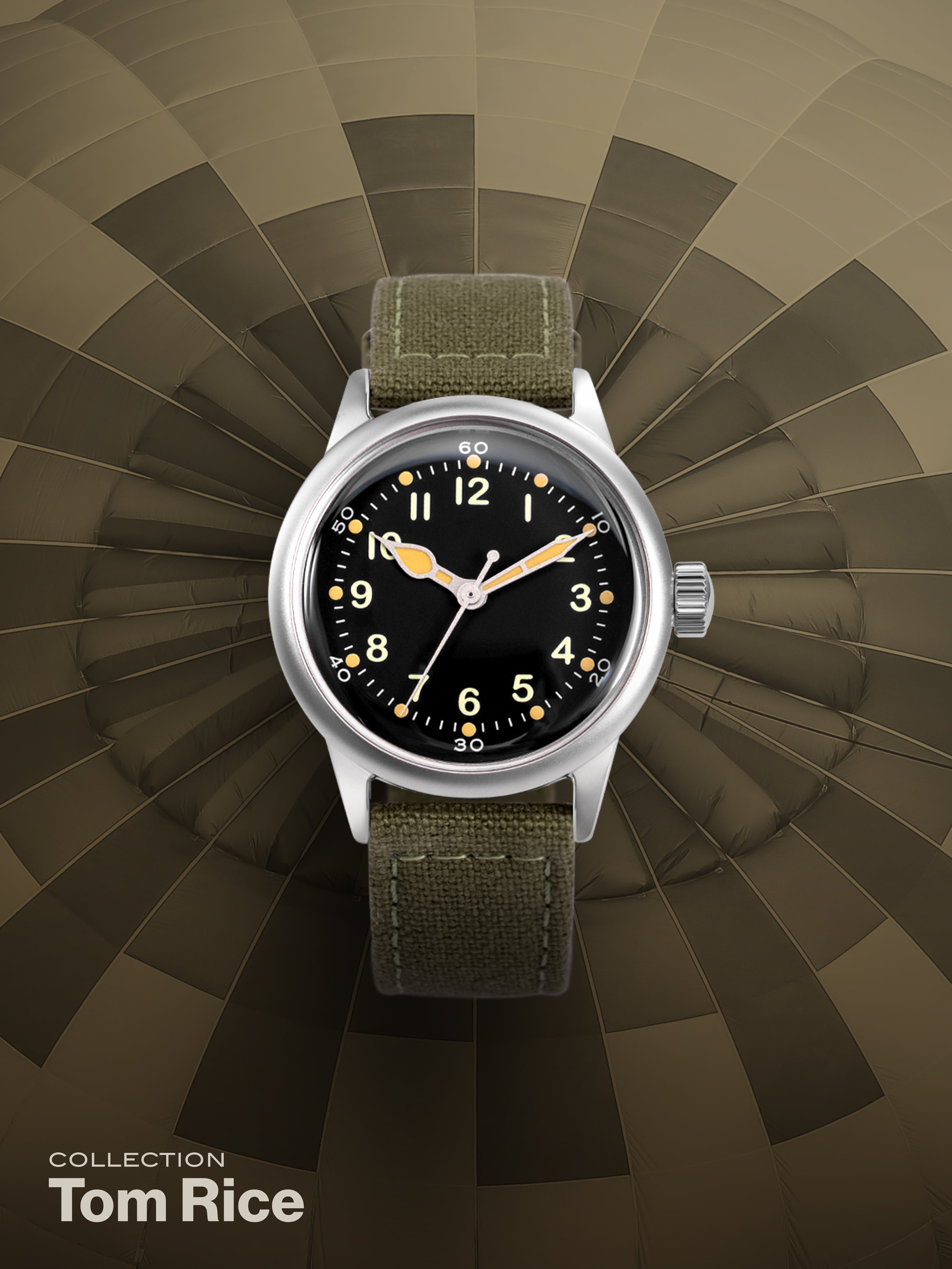
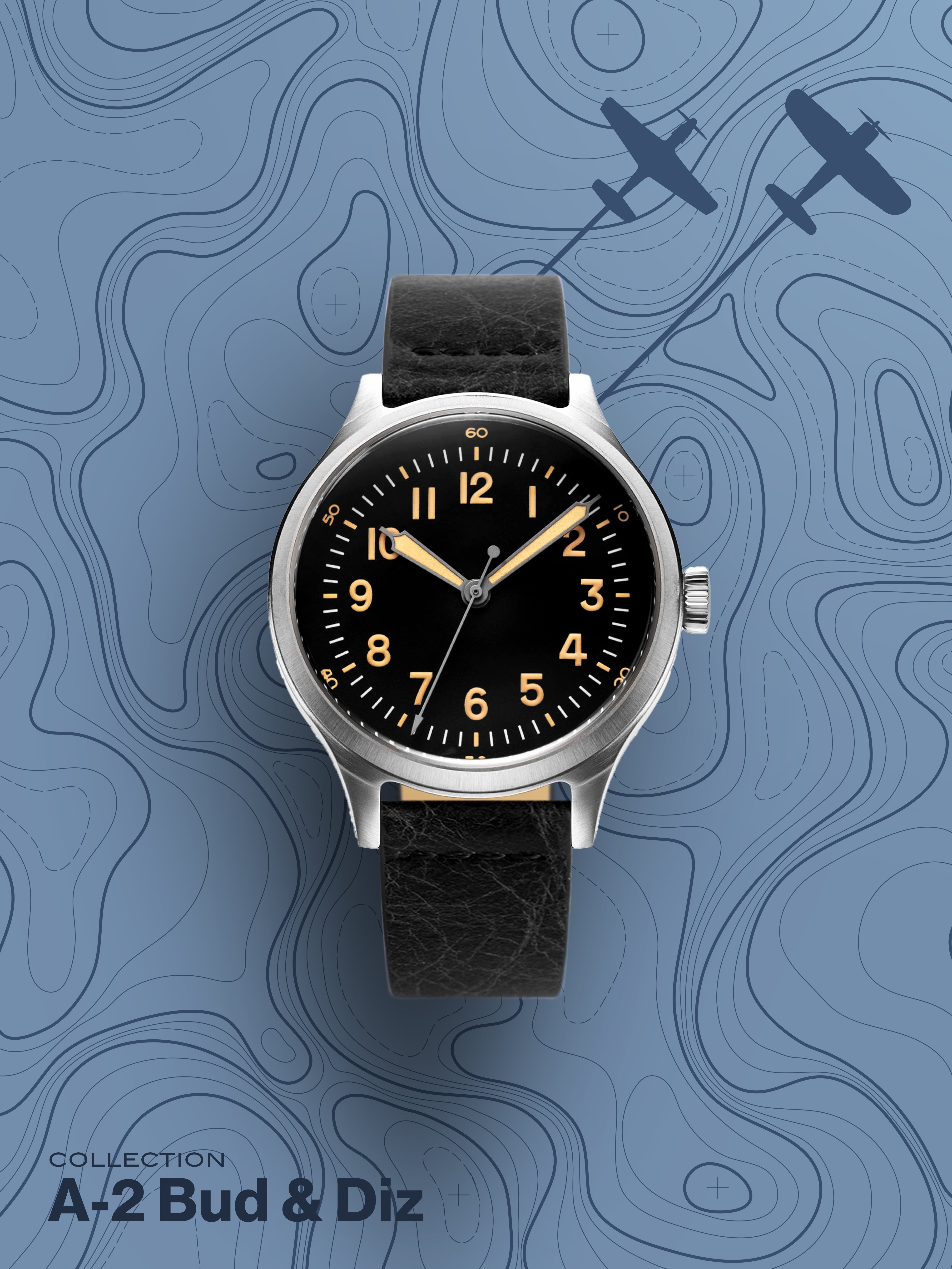
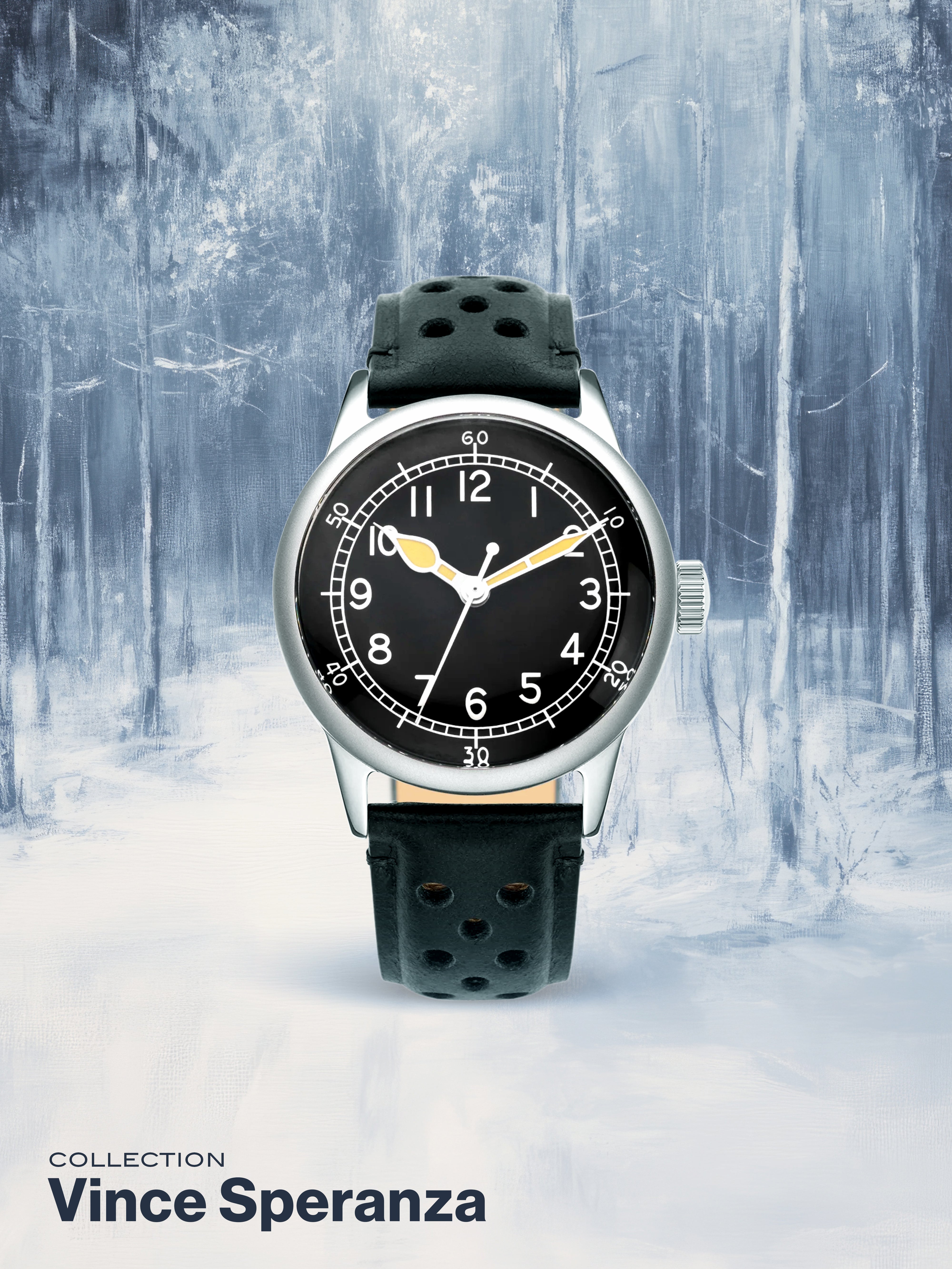
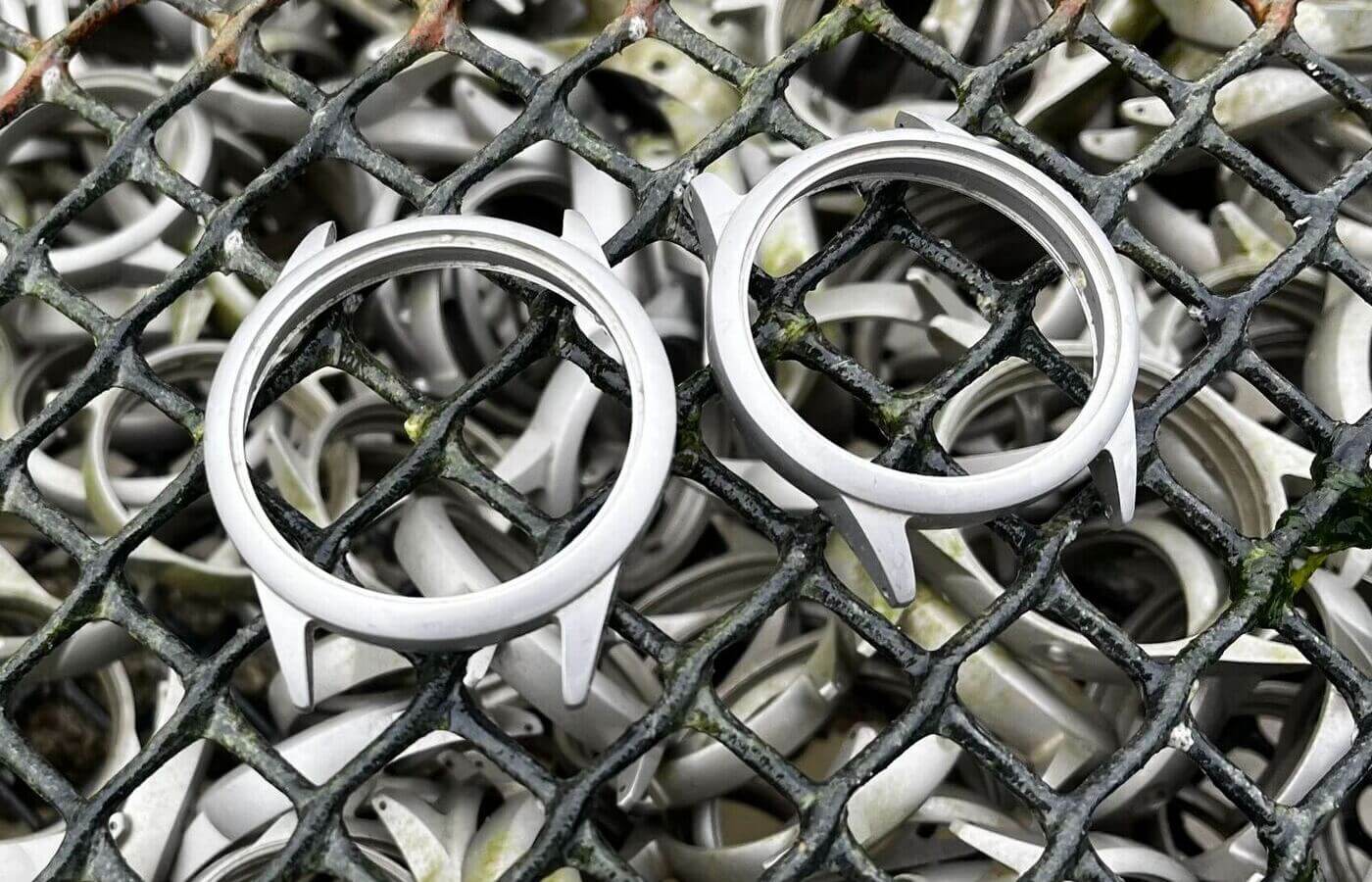
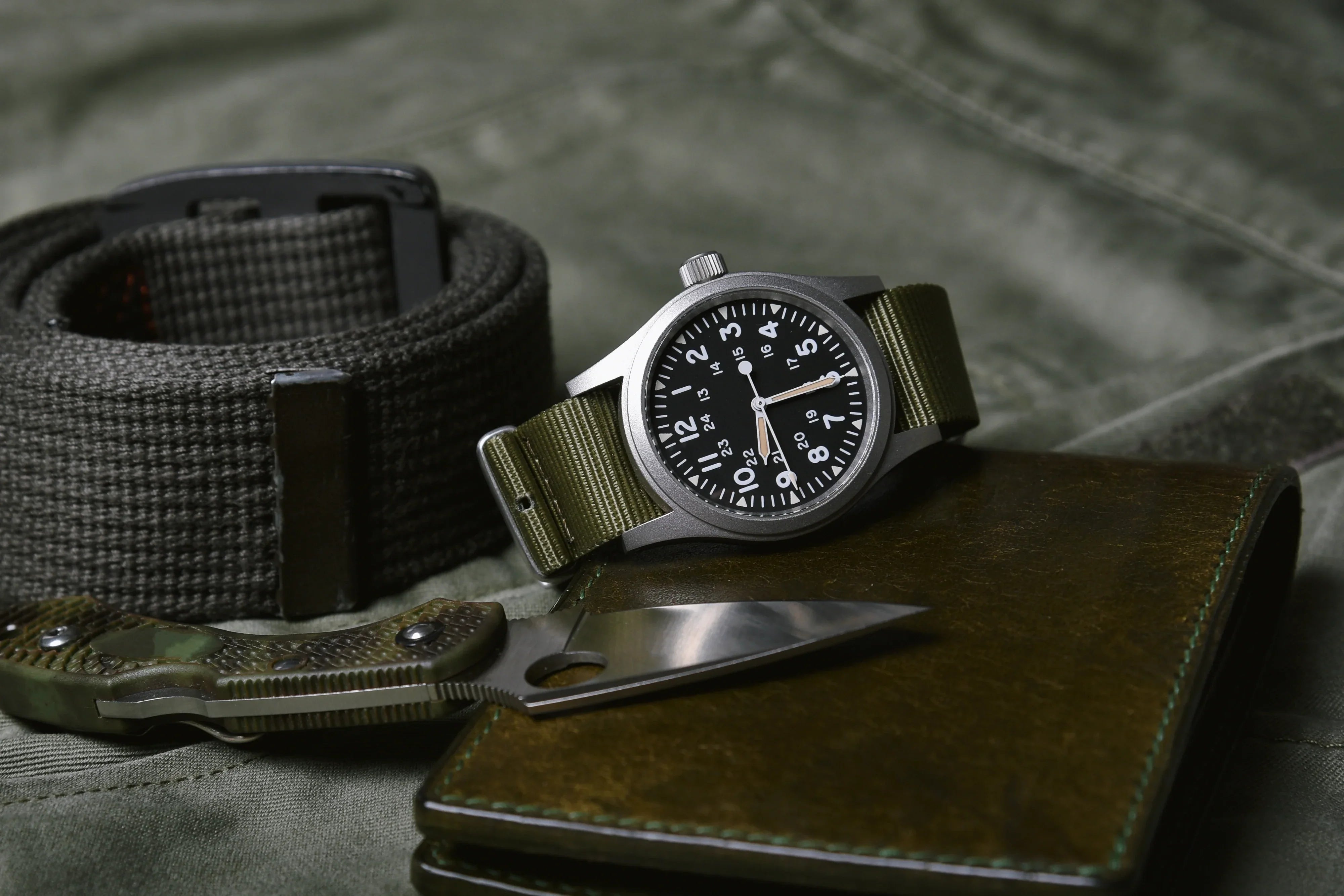
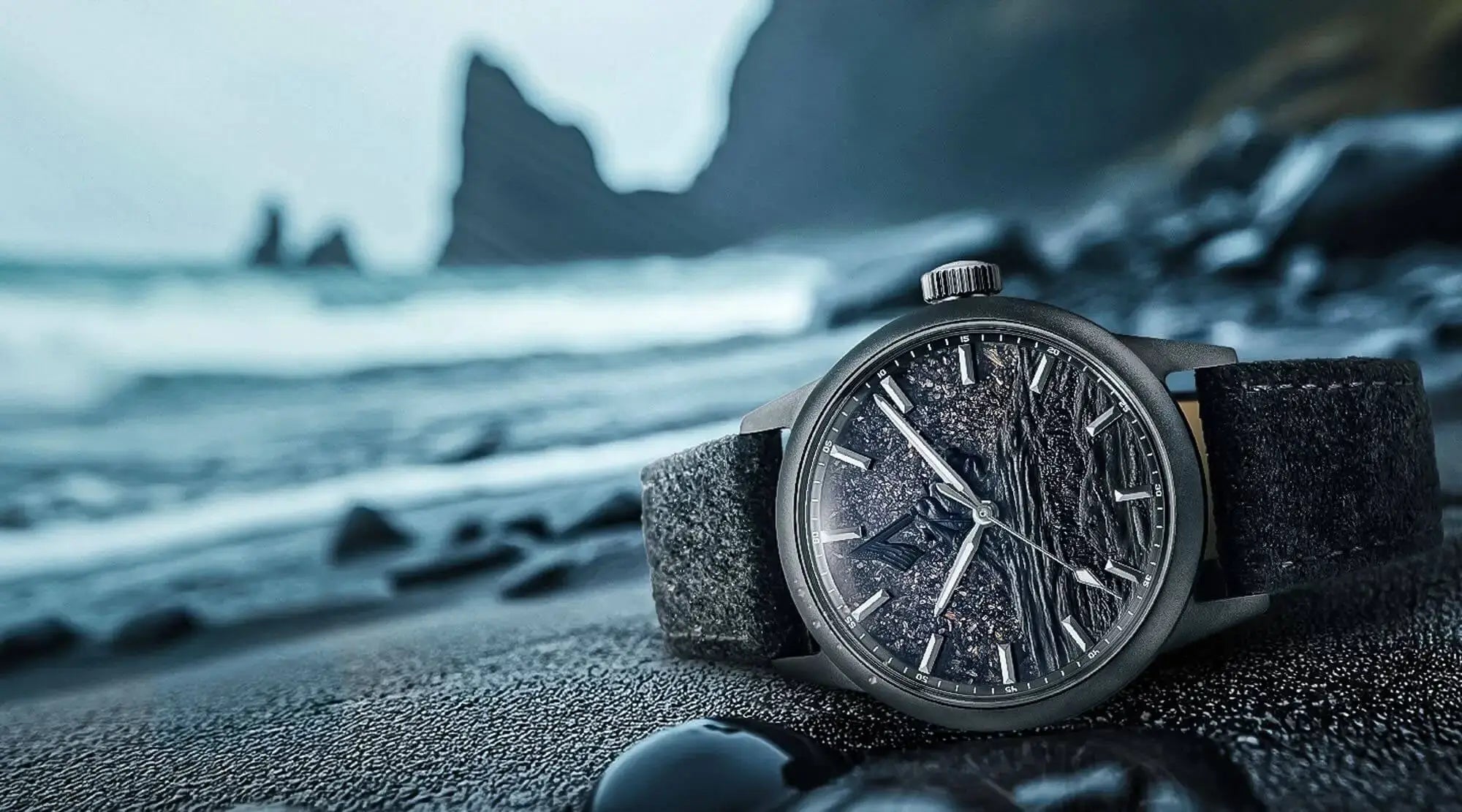
1 comment
Craig
Tec 5 Charles G Dunham
110th Ordnance Bomb Disposal Squad
Utah beach
June 6 , 1944
Leave a comment
This site is protected by hCaptcha and the hCaptcha Privacy Policy and Terms of Service apply.